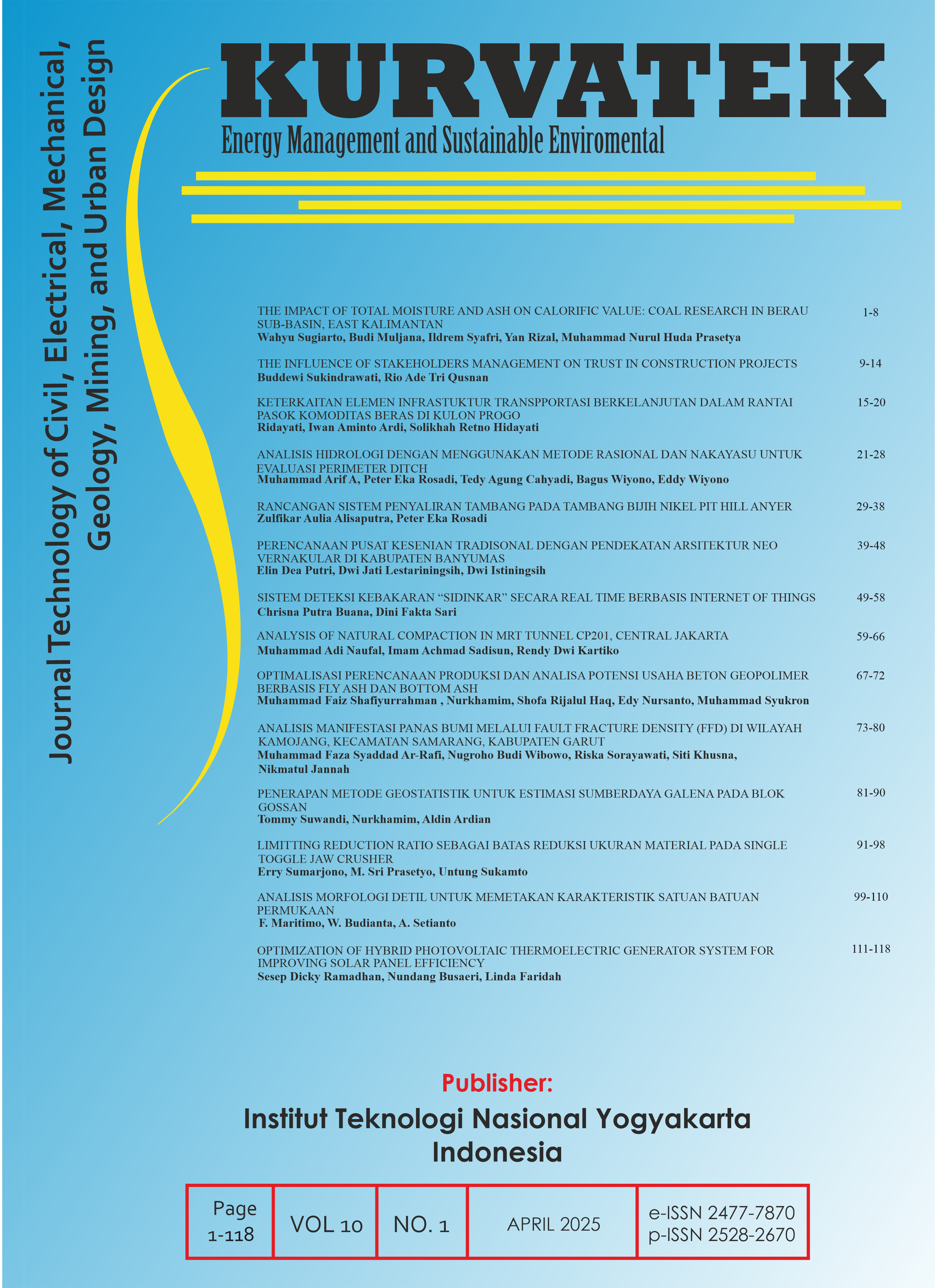English
DOI:
https://doi.org/10.33579/krvtk.v10i1.5539Kata Kunci:
Land subsidence, Natural consolidation, One-Dimensional Terzaghi, Finite elementAbstrak
This study analyzes the land subsidence caused by natural consolidation in the Thamrin Area, Central Jakarta, along the MRT CP201 tunnel route. Jakarta’s soft soils, particularly clay layers, contribute to land subsidence, with 0.2 to 3.6 meters and rate of subsidence is 1,24 cm/years. Using both analytical (one-dimensional consolidation) and numerical (finite element) methods, subsidence predictions were made based on geotechnical data from three boreholes which is TS-01,TS-02 and TS-03. Results show positive correlation between the two methods, with numerical approach yielding slightly smaller values due to its consideration of both vertical and horizontal deformations. This analysis highlights unavoidable nature of subsidence due to natural consolidation and emphasizes the need for mitigation and adaptation measures, such as spatial planning and monitoring systems, to minimize impacts on infrastructure.
Unduhan
Referensi
SAJV, Geotechnical Interpretative Report, Jakarta: PT MRT Jakarta, 2020.
SAJV, Geotechnical and Seismic Report, Jakarta: PT MRT Jakarta, 2021.
A. Darmawan, T. F. Fathani, dan I. Satyarno, “Analisis Perilaku Terowongan Sirkular Akibat Beban Gempa Dengan Pemodelan Elemen Hingga”, Thesis Magister, Universitas Gadjah Mada, 2018.
H. Andreas, H. Z. Abidin, D. A. Sarsito, and D. Pradipta, “Remote Sensing Capabilities on Land Subsidence and Coastal Water Hazard and Disaster Studies”, IOP Conference Serie: Earth and Environmental Science, vol. 500, no. 1, p. 012036, 2020.
G. Gambolati, P. Teatini, L. Tomasi, and M. Gonella, “Coastline Regression of the Romagna Region, Italy, due to Natural and Anthropogenic Land Subsidence and Sea Level Rise”, Water Resourches Research, vol. 35, no. 1, pp. 163-184, 1999.
Z. H. Abidin, H. Andreas, I. Gumilar, dan J. J. Brinkman, “Study on the Risk and Impacts of Land Subsidence in Jakarta”, Proceedings of the International Association of Hydrological Sciences, vol. 372, pp. 115–120, 2015. doi: https://doi.org/10.5194/piahs-372-115-2015
H. Harintaka, A. G. Suhadha, A. Syetiawan, M. Ardha, and A. Rarasati, “Current Land Subsidence in Jakarta: A Multi-Track SBAS InSAR Analysis During 2017–2022 using C-band SAR Data”, Geocarto International, vol. 39, no. 1, P. 2364726, 2024, doi: https://doi.org/10.1080/10106049.2024.2364726.
D. Sarah, “Kompaksi Alamiah Endapan Aluvial Semarang Demak”, Disertasi, Institut Teknologi Bandung, 2019.
W. R. Bemmelen, The Geology of Indonesia, vol. I A, Gov. Printing office, Martinus Nijhoff, The Hague, 1949.
N. R. Yong, E. Turcott, and H. Maathuis, “Groundwater Extraction Induced Land Subsidence Prediction: Bangkok and Jakarta Case Studies”, Proceedings of the Fifth International Symposium on Land Subsidence, IAHS Publication no. 234, pp. 89–97, 1995.
T. Turkandi, Sidarto, A. D. Agustyanto, and M. Hadiwidjojo, ”Peta Geologi Lembar Jakarta dan Kepulauan Seribu, Skala 1:100.000”, Pusat Penelitian dan Pengembangan Geologi, Bandung, 1992.
L. D. Wesley, “Fundamentals of Soil Mechanics for Sedimentary and Residual Soils (1 ed.)”, Wiley, 2010. doi: https://doi.org/10.1002/9780470549056.
B. M. Das, Principles of Geotechnical Engineering, 7th ed. (Seventh), Cengage Learning, USA, p. 688, 2010.
M. A. Biot, ”Theory of Propagation of Elastic Waves in a Fluid-Saturated Porous Solid”, The Journal of The Acoustical Society of America, 1956.
A. Syarifudin, N. Djarwanti and N. S. Surjandari, “Perubahan Parameter Konsolidasi Tanah Lempung Tanon yang Dicampur Ampas Tebu”, Jurnal Matriks Teknik Sipil, vol. 1, no. 4, pp. 356-362 Dec 2013. doi: https://doi.org/10.20961/mateksi.v1i4.37487
K. Terzaghi and R. Peck, Theoritical Soil Mechanic, New York: John Willey and Sons, 1943.
##submission.downloads##
Diterbitkan
Cara Mengutip
Terbitan
Bagian
Lisensi
Hak Cipta (c) 2025 Muhammad Adi Naufal

Artikel ini berlisensiCreative Commons Attribution-ShareAlike 4.0 International License.
This journal provides immediate open access to its content on the principle that making research freely available to the public supports a greater global exchange of knowledge.
All articles published Open Access will be immediately and permanently free for everyone to read and download. We are continuously working with our author communities to select the best choice of license options, currently being defined for this journal as follows:
• Creative Commons Attribution-ShareAlike (CC BY-SA)

This work is licensed under a Creative Commons Attribution-ShareAlike 4.0 International License.









